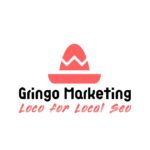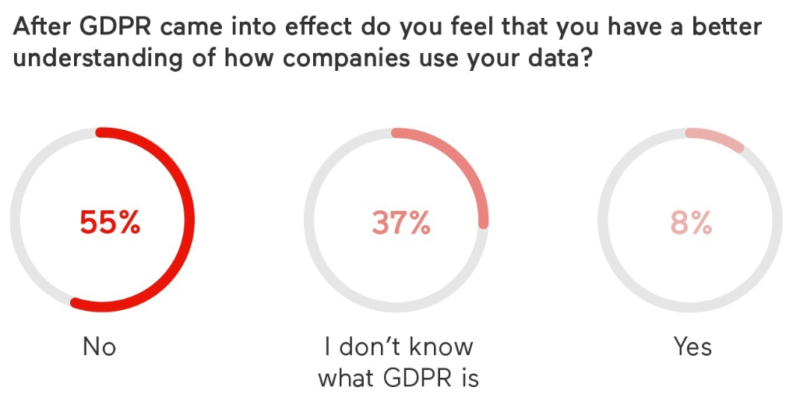Goodbye to average position on Google SERPs

Just when you thought Google was done shaking things up within their Google Ads platform, they did it again with their announcement that the “Average Position” metric would be sunset later this year.
Come September, we’ll have to start relying on the existing metrics “Top Impression Share” and “Absolute Top Impression Share” instead.
The change at first glance
It seems to simply and unnecessarily turn one metric into several, adding more complexity to the already vast data pool. However, the change is actually a chance to more accurately gauge the true page position of your text ads. The Average position has long been one of the most misunderstood metrics in the Google Ads ecosystem and can be a common source of confusion between client, agency, and Google teams.
Average position is going down
Average position is often interpreted as a metric that directly denotes the actual position your ad occupied on SERPs (Search Engine Results Pages), but that was never actually the case. Instead, average position denoted where your ad fell relative to other ads.
To illustrate the difference, consider that an ad with an average position of two could just as often be spotted sitting at the bottom of the results page as it could be found at the second overall results spot. The latter being in immediate view of a searcher without scrolling at all, the former often forgotten or dismissed.
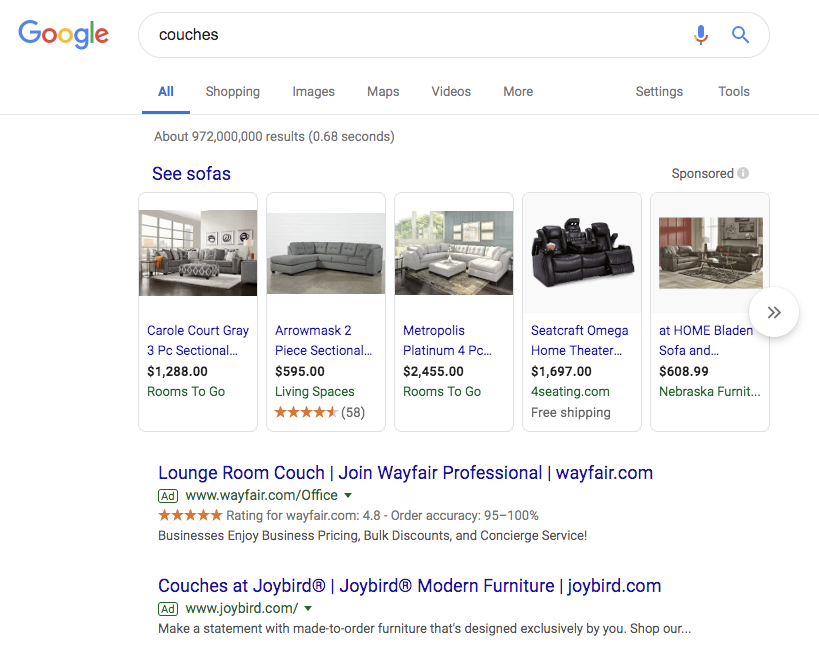
In these two separate instances, the ad from Joybird is just as much in average position two as the JustFab ad in the next picture.
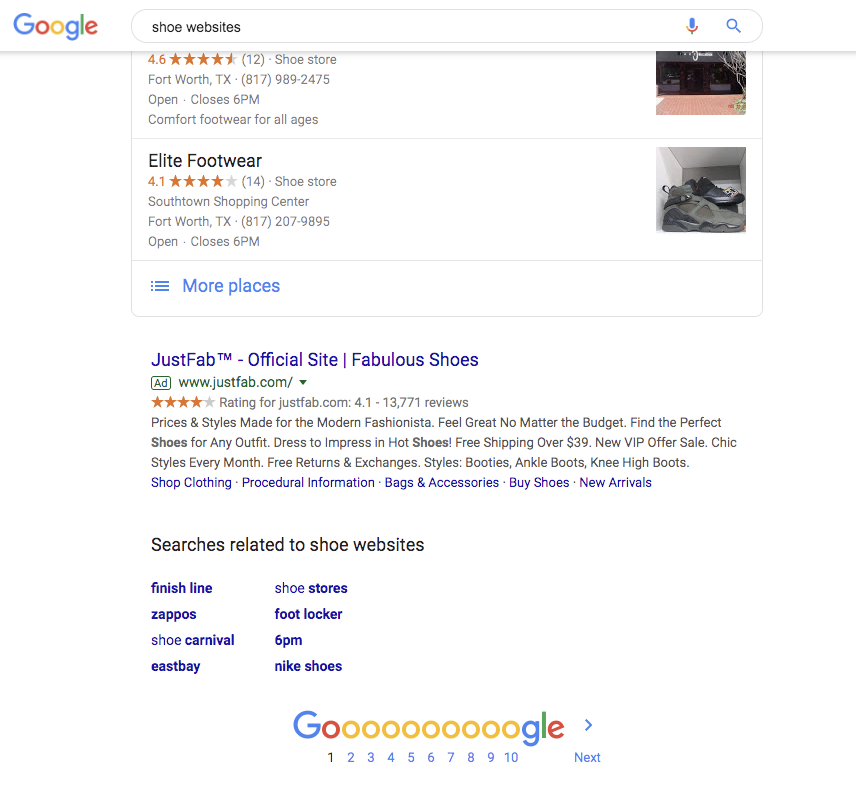
What are these “new” metrics?
“Top Impression Share” and “Absolute Top Impression Share” are actually much closer to the perceived intent of the average position.
Absolute Top Impression Share
“Absolute Top Impression Share” is defined as “the percentage of impressions your ad has in the very first position above organic search results”. This makes it ideal for knowing when your ad will be shown to a searcher without having to scroll. This is especially crucial when dealing with limited mobile real estate.
Top Impression Share
Meanwhile, “Top Impression Share” is defined as “the percentage of impressions your ad has above organic search results”. This will still be useful when gauging how your ad is being placed in relation to competitors.
While these new prominence metrics are a breath of fresh air, the jury is still out on just how reliable they are now and how reliable they will continue to be given the continuous testing of new page experiences and vertical-specific ad units (for example, hotel campaigns in Google Ads) along with other specialized knowledge panels.
Wake me up when September ends
With these “new” impression-share-based metrics taking center-stage in place of “Average Position”, there are plenty of misconceptions left to fuel more questions as time goes on, but the move should be fairly smooth given the ample amount of time we’ve been given to make the transition to using “Top Impression Share” and “Absolute Top Impression Share”.
With the wealth of data at our fingertips, now is the perfect time for search advertisers to educate themselves and their clients on the pitfalls of vanity metrics and the importance of focusing on clean, useful data that will actually improve returns.
Blake Lucas is an SEM Coordinator at PMG.
Related reading
Shopping on social media channels is spreading quickly as the next big thing. The rise of visual search is powered by people’s desire to discover brands.
The search industry’s interest goes beyond Google, Apple Search Ads’ on the rise. Kenshoo reveals insights and key stats on social and search advertising.
GDS, a free dashboard-style reporting tool launched in June 2016 allows data import from over 100 third-party sources. Updates listed with screenshots.
Learn how to target adjacent markets with smart risk-taking
Two running enthusiasts founded Nike in 1971 and created the first pair of Nike shoes using a waffle iron. Nike has come a long way since then – between the design of the signature swoosh, creation of the slogan “Just Do It” and endorsement from legends including Michael Jordan, the company has risen to a dynasty. One factor particularly contributed to Nike’s success: their repeated movement into new fitness markets in a specific, scalable way. Through targeting adjacent markets, Nike expanded its reach into new sports (mountaineering, for example) and sets of customers (like young athletes).
Just like Nike, many of the world’s largest companies, especially software companies, can accelerate their success through expansion into adjacent markets – but it’s a feat that requires a high degree of intelligent risk-taking. With research illustrating only three percent of software startups grow into companies boasting an annual revenue of at least one billion, it’s clear many struggle to make it past an initial “growth spurt.” Software companies can’t afford to stand still; they need to evolve by constantly moving into new markets.
To target adjacent markets successfully, high-tech marketers can’t lose sight of their companies’ original target market – but they do need to walk a fine line between risk-taking and staying true to their core audience. Here are three ways marketers can practice smart risk-taking into new adjacencies.
1. Identify the right moves through customer insights
With a surplus of emerging technologies coming onto the scene, marketers can face decision-paralysis when it comes to choosing which tools to incorporate into their business and new markets to pursue. Customer-centricity is key. Cutting through the noise of overwhelming choice and buzzword technologies means zeroing in on customer buyer and budget trends to understand exactly which markets to target.
Because metrics have become the lifeblood of marketing, modern measurement tools make it simple to gain consumer insight, analyze granular data and find common threads. You can also glean insight into what’s working through digital marketing methods like customer email surveys. Ask your most loyal customers to share feedback on what products would make their lives easier or ways you could boost the value of a current solution. Human-to-human methods of gaining feedback work well in tandem – through in-person focus groups, for example, you can bring together a mix of loyal and newer customers to discuss trends and collect valuable insights. Gathering customer opinions through both digital and in-person methods can help you make an informed choice on a new adjacency to target that will both power your current customers and let you enter new markets.
2. Be willing to let go
Once marketers determine which adjacency they’ll target, it’s usually time to hand the reins over to a leader who “speaks the language” of this new market. This means giving up ownership and providing autonomy to new leaders, as well as letting the initiative run unencumbered from the core of the business. If you force integration of the adjacency into your core business, it will simply wither on the vine. Treat your new market like a small but mighty startup, and give it the critical safe space it needs to grow and build momentum.
This also means letting go of the pressure to tie to the mainstream right away. Allow your new adjacency to play out in parallel or perhaps even in competition with your core market.
If you watch the work of an adjacent market at your company and catch yourself thinking “I don’t like what they’re doing,” that might be a good sign – it signals you’ve stepped out of your comfort zone and can allow positive change to occur. Moving away from what’s familiar means getting used to new metrics, too. For new market entry, rather than tracking revenue, metrics or pipeline, consider instead measuring quality and use cases you can share with the broader market.
3. Keep your eye on your core audience
Marketing to new adjacencies successfully means staying true to your core market while taking calculated risks. One way to ensure you don’t lose sight of your original consumer market is to target just one new adjacency at a time. Focusing on only one at first will enable you to provide ample resources to leaders and marketers of this new adjacency so they can execute like a startup while you simultaneously tend to your core market of customers.
In Geoffrey Moore’s book “Crossing the Chasm” about marketing and selling high-tech products to mainstream customers, he covers the importance of starting small when it comes to targeting a new customer niche. He compares the initial phase of entering a new market to securing a beachhead in an invasion before you take a stand and build it from there. For example, Mark Zuckerberg built out Facebook’s marketing strategy by first starting small and targeting college students as primary consumers. Once he drove interest on campuses, he created enough of a presence to start expanding into other consumers across the world.
Successfully branching out into adjacent markets might mean making uncomfortable strategy shifts at first, but these changes will lead to the expansion of your core business. As long as you complete the transition to a new adjacency thoughtfully, your organization will reap the benefits – including an increase in consumer base, profit and brand awareness.
Opinions expressed in this article are those of the guest author and not necessarily Marketing Land. Staff authors are listed here.

Is GDPR working? Brave’s Johnny Ryan says it’s starting to, and marketers must heed the risks
Tomorrow is the one year anniversary of the EU’s General Data Protection Regulation (GDPR). The landmark law created a unified, pan-European approach to privacy and data regulation. It was designed to protect EU citizens against non-consensual data collection by global tech companies and give individuals more control over their personal data. It also carries potentially severe penalties for violators.
Since being implemented last May, GDPR has impacted privacy debates around the world. It has also been an influence on California’s forthcoming CCPA, set to take effect next January. But has GDPR accomplished what it set out to do; is it working?
For perspective, we asked Johnny Ryan, chief policy and industry relations officer at Brave Software. A long-time privacy advocate and vocal critic of industry data-collection practices, he was substantially responsible for the recently announced Irish investigation into potentially improper exposure of personal data in Google’s programmatic platform.
We invited him to reflect on the impact of GDPR on the digital ecosystem and how it has changed the lives of marketers. Most of the changes Ryan expects have yet to take place, as he discusses in the interview below.
ML: What have been the most significant effects of GDPR on marketers and brands?
JR: Marketers are now controllers, even when they do not realize that they are. This exposes them to legal hazards, and will ultimately cause them to be more careful about the targeting that is used in their campaigns. In June the European Union’s highest court ruled that marketers are responsible for how data is used in marketing campaigns — even if they never directly touch the data.
The European Court of Justice ruled that a marketer’s use of Facebook for advertising “gives Facebook the opportunity to place cookies on the computer or another device of a person visiting its fan page, whether or not that person has a Facebook account.” In addition, the Court observed that the marketer “can ask for — and thereby request the processing of — demographic data relating to its target audience” such as age, sex, relationships, occupation, lifestyles, areas of interest, purchases and online purchasing habits, and geographical data.” According to the Court, a marketer is therefore “a controller responsible for that processing.”
This applies to RTB: marketers are liable as “controllers” of the processing undertaken by the various adtech businesses involved in the RTB system on their behalf. RTB broadcasts personal data without security in hundreds of billions of bid requests every day. It is the most massive data breach ever recorded. Marketers now find themselves liable for it because of the adtech companies they or their agencies work with.
ML: What has changed in the day-to-day lives of marketers following GDPR?
JR: Most marketers are not aware of the risk that RTB companies expose them to. Otherwise, they would already have conducted data protection impact assessments (DPIAs), as required by Article 35 of the GDPR. DPIAs are required when AdTech is profiling and using intimate personal data (referred to as “special category personal data” in article 9) on a large scale to target people in the European market. The inescapable conclusion of any such assessment is that RTB is a “data protection free zone,” as The Economist indicated. This conclusion triggers Article 36 of the GDPR, requiring a marketer to alert a data protection regulator in an EU Member State about the risks it has uncovered.
ML: What changes have you observed in data collection practices?
JR: Change has yet to happen. As I told the Senate Judiciary Committee when I testified this week, we are at the very start of the application of the GDPR. But things are looking bleak for Google, Facebook, and the conventional RTB companies. They will be forced to reform.
ML: There seems to be a fair amount of non-compliance with GDPR. Why haven’t there been more fines or callouts of violators?
JR: [This week] the Irish Data Protection Commission announced that it was launching a probe of Google DoubleClick/Authorized Buyers on suspicion of infringement. This, finally, marks the start of enforcement action that will force adtech to reform.
ML: Have there been any “unintended consequences” of GDPR? For example, some argue that it has strengthened the hand of dominant companies vs. smaller competitors.
JR: First, let me dispel this idea that Google and Facebook benefit from the GDPR in the medium term. The GDPR is risk-based. That means Big Tech that creates big risks get big scrutiny and potentially big penalties. Regulators are only starting to enforce the GDPR and it will take years to have full effect. But already, things are looking bleak for our colleagues at Google and Facebook. Their year-over-year growth declined steadily in Europe since the GDPR – despite a buoyant advertising market.
They face multiple investigations and it is very likely that they will be forced to change how they do business. Google’s consent has already been ruled invalid. Yes, of course things are even bleaker for other tracking companies, that don’t have a search business to fall back on, as Google does.
Second, let me talk about the nonsense “consent” notices that currently despoil the Web. The IAB’s consent gambit was certainly an unintended consequence. However, these annoying and unlawful consent notices will become a rarity, if there is enforcement. Article 7 (3) of the GDPR requires that an opt-in must be as easy to undo as it was to give in the first place, and that people can do so without detriment.
Once this is enforced, consent messages will become far less annoying in Europe – because if a company insists on harassing you to opt-in, and you finally click OK, it will be required to keep reminding you that you can opt back out again. In addition, most of the consent notices are for RTB companies whose processing is itself unlawful. So enforcement against Google and the IAB on RTB will prevent the majority of these notices.
ML: Finally, what does the experience of GDPR in Europe say about the implementation of CCPA in the US?
JR: Very little. Although its animating principles are noble, I think the CCPA is a pale imitation of the GDPR.

Roku’s new Activation Insights tool targets viewers who have shifted to streaming
In a bid to entice digital TV marketers with more value and advertising opportunities, Roku introduced a new tool this week dubbed Activation Insights. The tool is designed to compare linear TV ads with potential OTT campaigns, giving advertisers visibility into the potential audiences they could be reaching on the streaming platform.
“Smart marketers are significantly increasing investments in OTT to reflect the dramatic shift to streaming,” said Scott Rosenberg, SVP and GM of Roku’s Platform business. “By adding the ability to tie advertising performance on linear with a specific audience that advertisers can gain on OTT, we are addressing a long-standing industry challenge for OTT media planning.”
Why we should care
With the streaming landscape becoming increasingly fragmented as OTT platforms strive to keep pace with linear TV, digital marketing budgets are getting caught in the crossfire. Rosenberg said, “We believe it’s no longer a question of when advertising budgets will shift to streaming but how much.”
Tools that can help measure the reach and ROI of OTT campaigns are becoming more essential to marketers as they build out their media strategies and assign ad dollars.
Roku’s continued investment in its ad product underscores the race against competing platforms (like Amazon’s), but it’s important for advertisers to consider the long-term investment impact and health of the platform before taking the plunge. Factors like subscriber rates, screen share, viewing time and incremental revenue growth should be taken into account to determine the right amount of ad spend for the right type of streaming platform.
More on the news
- Activation Insights uses Roku’s first-party data from a reported 29.1 million active accounts to supply media planners with insights that can be helpful in allocating TV budgets and building campaigns.
- The tool lives under the larger umbrella of the Roku Ad Insights – an analytics suite meant to help advertisers identify and optimize campaign reach across linear TV and OTT.

The middle ground for single keyword ad groups (SKAGs)

Aside from perhaps the most unfortunate acronym in the industry, do single keyword ad groups (SKAGs) have a role in modern paid search?
For many years, single keyword ad groups were the hallmark of good PPC strategy. And aside from a slight feeling of unease when saying the word, SKAGs appeared to offer much.
In simple words, this was the practice of placing single keywords in an ad group, instead of a small group of closely themed keywords. This provided the advertiser with increased control, the ad copy could contain the exact keyword, maximizing relevance and the quality score. Match types and negative keywords could be used to ensure queries were matched to your keyword exactly, providing precise control over visibility. And finally, you could easily understand the true performance of an individual keyword.
Complexity at scale
Arguably, however, the benefits of this approach were incremental when implemented in an otherwise well organized and maintained PPC account structure. In fact, the benefits could be outweighed by the challenges they posed.
The complexity of the SKAG structure, when operated at scale, could jeopardize accuracy. For example, if you were operating a standard structure with 1,500 keywords, averaging three ads and five keywords per ad group, you would be managing 900 individual ads. Convert this to a SKAG structure, maintaining three ads per ad group, and that number jumps to 4,500 individual creatives to be maintained.
Not only that, but the application of cross-matching negatives to stream traffic accurately across this number of ad groups makes it significantly more complex. This is just a simplified example with a modest number of keywords, retailers with a large product range may operate keywords in the tens of thousands.
Operating SKAGs at scale increases the chances of inadvertently blocking traffic to keywords, as well as poor quality or inappropriate ad copy being overlooked. Both of which would have negative impacts on performance. To mitigate against this, increased amounts of “housekeeping” work is required, either detracting from more strategic work to develop and grow the activity or increasing costs to allow for the extra resource required.
So, are the merits of the SKAG structure outweighed by the effort to maintain them? Or even worse, and perhaps ironically, do they increase the risk of inaccuracy?
Are SKAGs still relevant?
Putting this question aside, there is a question over whether SKAG is even appropriate in contemporary PPC accounts.
In a greatly discussed recent article, Emma Franks of Hanapin Marketing makes the case that SKAGs no longer serve as a best practice for paid search. Her argument is centered around the evolution of Google’s match types, which are shifting to better match keywords to the user’s intent, rather than simply matching words to the query.
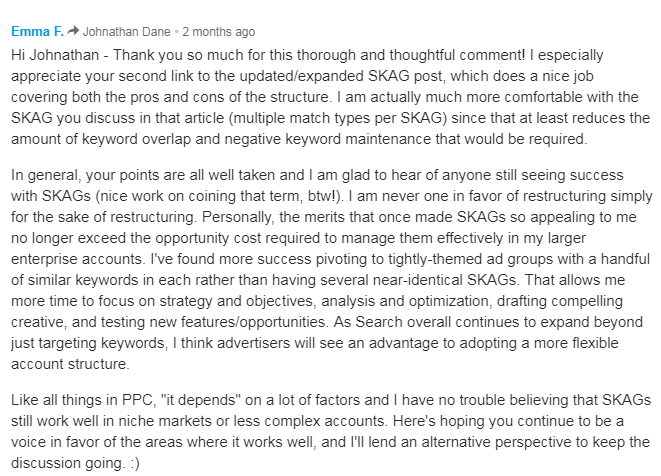
Source: Unbounce
This means that a single keyword could effectively be matched to many variations, all of which are relevant and have the same intent. The below example of how this works is taken directly from Google Ads Help pages:

Source: Google Inside AdWords
This level of variant matching then implies that to truly achieve the goal of the SKAG structure, which is, complete control over what queries match and the creative that is served, the extent of negative cross-matching required would become too taxing and hard to achieve.
Emma’s summary of the potential issues was
- Multiple ad groups that address the same keyword intent
- Duplicated ad copy that is no longer customizable for each individual search
- Cross-contamination among keyword search terms for multiple ad groups
- The potential for missed impressions/clicks/conversions/revenue due to an overabundance of negative keywords
- Wasted time spent on keyword additions and exclusions, ad copy testing and revisions further topped with stress about new Google updates
Essentially, as Google increasingly takes benefit of machine learning to match ads better with the user’s intent, the SKAG structure offers advertisers an increasingly more difficult way to grab that control back from Google and control it manually. But, in an industry that is being driven by automation, machine learning, and AI, can a manually-controlled account ever keep up?
Is there a middle ground?
So then, SKAGs are a challenge to manage at scale and essentially pull in the opposite direction to the way in which Google is developing the Google Ads offering. In this case, they don’t have a place in a well-managed PPC campaign, right? Well, not entirely.
Where individual keywords command a very high share of the overall search volume, placing those terms in ad groups all of their own can offer greater flexibility. You get the control over the matching landing pages and copy SKAGs provide but at an infinitely more manageable scale. But you can also apply specific audience targeting, demographic and device modifiers and, day-parting at an effective keyword level. This provides a lot more levers for optimization of such high-volume terms. Take things a step further and place each SKAG in its own campaign and you now can apply specific budgets, the ad rotations, and delivery methods for that keyword, as well as its very own bid strategy.
Once again, this comes back to an assessment of “effort vs reward”. To be truly worth it and indeed to make automated features such as bid strategies work, the individual keywords themselves must drive a high volume.
A blended approach
So in the war of opinions on this subject (refer back to the comments section of Emma Franks article!), there is an answer to the entire “mixed feelings scenario” for SKAGs. Yes, SKAGs do have a role in effective PPC activity, but they should be used strategically alongside other strategies to maximize performance.
High-volume hero or brand terms can benefit from the SKAG structure to increase the levels of control and flexibility at a keyword level for the terms that drive the largest proportion of your traffic. Using traditional, tightly themed ad groups for the bulk of your remaining inventory will ensure more manageability while it continues to deliver performance. Finally, tools such as Dynamic Search Ads can offer a “catch-all” strategy to capture new and emerging search terms when deployed correctly.
An approach such as this provides maximum control over the terms that drive the most performance, whilst also allowing advertisers to reap the benefits of machine learning and automation to efficiently and effectively manage the body and long tail terms.
Advertisers are all different, so inevitably, each paid search structure will be unique as a result. The key, as ever, is finding the right balance that works for you.
Jon Crowe is Director of PPC Strategy at a global digital marketing agency, Croud.
Related reading
The search industry’s interest goes beyond Google, Apple Search Ads’ on the rise. Kenshoo reveals insights and key stats on social and search advertising.
Most of the time, people that gather information to find suppliers are engineers, managers, and CEOs. How to create a content strategy that speaks to them?
SEO methods and insights are supporting strategy and decision making beyond website content. Uncover the broader use of SEO intelligence in evolution.
GDPR: A ‘Y2K’ moment or a sea change for the digital ecosystem?
There was a lot of hand wringing leading up to last May’s implementation of GDPR. But since that time there have been few fines or enforcement actions, with the notable exception of a $57 million fine imposed on Google and a new investigation in Ireland. This raises the question: is GDPR is the current digital generation’s “Y2K” moment — a highly anticipated event with little real-world impact.
Limited impact on consumers
From a consumer standpoint, GDPR has had not had a significant effect on people’s daily lives. According to survey data from TrustArc and Ipsos, 66% of more than 2,000 UK consumers said they didn’t know or disagreed with the idea that GDPR been effective. And only a tiny minority had exercised any of their personal data rights under GDPR.
Another UK-based survey from BounceX found that while 71% of UK consumers were familiar with the term GDPR and 56% supported the regulation, most consumers had not changed their online activities in its wake. Further, a global survey from Ogury, of more than 287,000 consumers, found only 8% of consumers had a better understanding of how companies use their data since GDPR.

Source: Ogury (n=287,000 global consumers)
While this was a global sample and one would not expect equal awareness of GDPR across all regions, “In European countries where GDPR has been in effect for more than a year now . . . 39% of European respondents were unaware of what GDPR is at all.”
Marketers more cautious
But what about marketers and their day to day activities; how have those changed? Here there was a more pronounced impact on daily life. However, there was also still a good deal of uncertainty.
According to Darren Abernethy, Senior Counsel, TrustArc, “GDPR forced marketers and brands–including many with no offices or employees in the EU–to evaluate whether their pre-GDPR contacts and leads were still adequate as-is for today’s use.” He added, “Because of GDPR’s potentially global reach, many marketers continue to work through using updated EU vs. non-EU campaign parameters, different flags within databases and their CMS, and potentially different website cookie/tracker load experiences. It has also led to a greater wariness in relying on bought-in lists without strong contractual guarantees and consent audit trails to support them.”
Paul Harrison, CTO at Simpli.fi said, “Many targeting methods that are threatening to PII can no longer be employed. Advertisers, brands, marketers, etc. cannot touch data or media that does not have the appropriate consent strings attached, forcing them to think differently and implement new ways of targeting and connecting with consumers.” He further explained, “User requests that come in can be difficult to manage as people do not want any advertising versus not just tracking. Engineering efforts take much longer to meet compliance, not to mention the additional costs associated with the day to day requests and management of compliance and audits.”
Benoit Grouchko, CEO of Teemo, pointed to “privacy by design” as a significant shift in the wake of GDPR. “Everyone now thinks about potential impacts on privacy for any data-driven product: how users would feel about it, potential risks, how to limit impact on privacy, etc. This is a significant change in mindset and strategy. Whenever data is involved in a marketing plan, marketers make sure they know where this data comes from, how it has been collected and consent has been given, whether it’s compliant, etc.”
Johnny Ryan, Chief Policy and Industry Relations Officer at Brave Software, told us that most of the changes that he anticipated hadn’t happened yet. “Most marketers are not aware of the risk that RTB companies expose them to,” he said. “Change has yet to happen . . . we are at the very start of the application of the GDPR.”
Google, Facebook and unintended consequences
One popular perception is that a GDPR “unintended consequence” is the strengthening of Google and Facebook. This is arguably the opposite of what the EU wanted to accomplish with GDPR.
Teemo’s Grouchko said that it “has strengthened Google and Facebook vs. smaller competitors as a side effect indeed. Google and Facebook have so many touchpoints with their users that they can find ways to have them accept pretty much anything. For smaller publishers or vendors, having much fewer interactions with users makes it harder to gather the same level of consent, and as a consequent to remain competitive from a data standpoint.”
Simpli.fi’s Harrison generally agreed. “The big marketers ended up with more market share and less competition,” he argued. And TrustArc’s Abernethy opined, “The so-called ‘walled-gardens’ have enjoyed the benefits of owning the first-party relationships with consumers and setting the terms of transparency disclosures and consents for processing purposes.”
Market-share data also seem to support the idea that Google and Facebook’s relative competitive positions in Europe are stronger than they were before GDPR. However, Brave’s Ryan disagreed with the others’ assessments.
“Let me dispel this idea that Google and Facebook benefit from the GDPR in the medium term. The GDPR is risk-based. That means Big Tech that creates big risks get big scrutiny and potentially big penalties. Regulators are only starting to enforce the GDPR and it will take years to have full effect. But already, things are looking bleak for our colleagues at Google and Facebook. Their year-over-year growth declined steadily in Europe since the GDPR – despite a buoyant advertising market,” he argued.

Don’t let unwanted automated ad extensions keep you up

It’s three a.m. You’re uneasy, but you don’t really know why. You’ve recently audited your accounts, you’re on top of your routine maintenance, and you’re actively testing ways to increase efficiency and grow your account.
You’ve done your due diligence, so why the nagging feeling that something’s wrong? Since you can’t sleep, you decide to check up on your ads in the wild and run a live search to put yourself at ease. That’s when it hits you. Your ads are showing with extensions you didn’t specify. Even worse, some of them don’t even really make sense.
What are these, and where did they come from?
By default, campaigns on Google and Bing are automatically eligible to show dynamic extensions, ranging from site links, callouts, structured snippets, call extensions, and app extensions. Additionally, Bing offers “Dynamic Ad Enhancements” which are anything from dynamically generated ad description texts to badges highlighting promos and deals.
The content of these extensions is based on your landing pages, ad copy, information from your domain, your Google My Business profile, and third-parties in the case of reviews and seller ratings. The exact logic Google and Bing Ads use to determine when automated extensions show is a closely held secret, as is the content of those extensions themselves. Only performance metrics associated with the type of extension is viewable in each interface.
Depending on how your site is indexed and crawled by each platform, wildly different data is available to populate these extensions. That could lead to showing outdated information or content from irrelevant pages with your ad. Seeing an extension driving particularly strong performance without being able to see what that extension actually is is incredibly frustrating, but seeing an irrelevant or outdated addition to your ads on a live search is even worse. Even more so if your client happens across one before you do.
While each platform is heavily invested in improving overall user experience and improving ad experiences, automated extensions are far from perfect. Further, SEM managers frequently need to maintain control over ad messaging for legal compliance and client needs. Some examples would be adherence to branding guidelines, highlighting specific events and promotions, and using particular approved language. These make automated extensions a non-starter regardless of performance.
Measuring the impact of extensions
Both Google and Bing warn against the potential negative performance impact of opting out of automated extensions. If your account doesn’t have specific branding or compliance requirements, you should gauge automated extension performance against your existing extensions before opting out of anything. There will be clear winners and losers in every account. As automated extensions are frequently changing, their performance is likely to ebb and flow. Hopefully, dynamic extensions that don’t resonate with users get weeded out of the mix by the ad platforms.
When you find something that works, it’s nice to be able to build on it. Similarly, if you find something doesn’t work, it’s a great time to stop doing that. Unfortunately, both ad systems seem determined to make certain extensions work, even when their performance doesn’t merit keeping them around. And, since both the underpinning logic behind automated extensions serving as well as the content of those extensions is a mystery, it can be difficult, if not impossible, to get a good handle on what exactly is driving those decisions.
To quantify the impact extensions have on your account in Google, analyze ad performance segmented by click type to determine which part of an ad unit users are interacting with. To determine how individual extensions perform on the ad level, segment your data with This Extension vs Other. In Bing, there are multiple ad extension reports available within the Reports tab just not directly in the interface.
How do I get rid of these?
To manage your dynamic extensions in the Google Ads interface, click into the “Ads & Extensions” tab, and then click into the “Advanced Options” menu on the far right-hand side of the screen.

In the Bing Ads interface, you’ll need to click into the “Ad Extensions” tab and select the dropdown menu to choose “Automated Extensions Report”. From there, the “Manage Automated Extensions” button is clearly accessible.
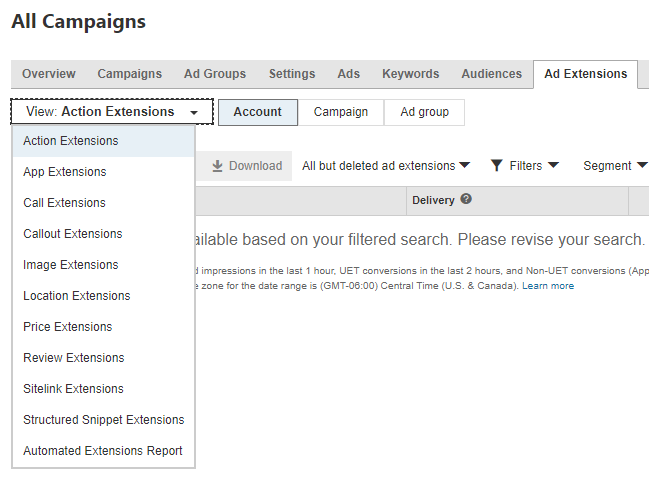
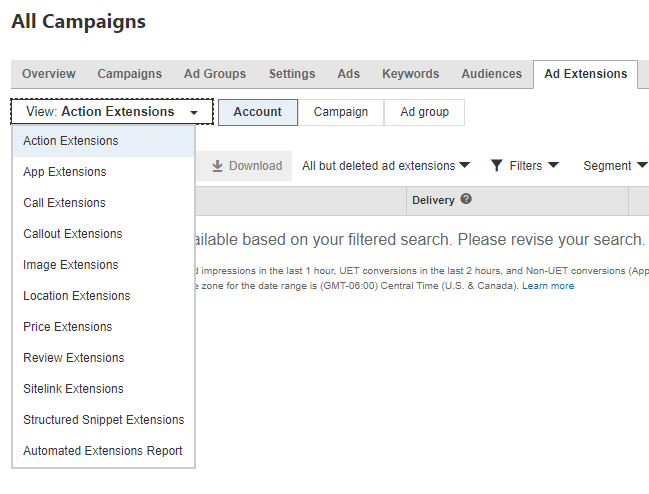
As soon as you get to the appropriate section in both platforms, opting out of undesired extension types is as simple as checking a few boxes.
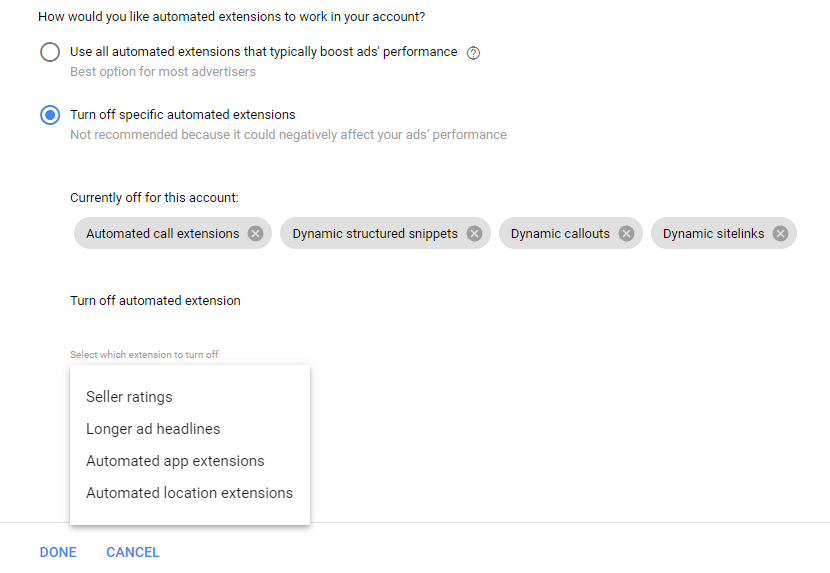

As your settings are updated in the interface, they should roll live in the same amount of time it takes any other change, which is usually within 15 minutes.
As always, performing a periodic live search to verify if ads are serving appropriately is a life saver. Make a note on your calendar to include checking your automated extensions settings periodically when you move through your deeper account health checks.
Now that you’ve regained some control over your account, you can breathe a sigh of relief, and look forward to restful slumbers. But when you wake in the morning, we think that’d be a great time to audit your current extensions. Make sure everything serving is timely and applied to the appropriate campaigns. Ad extensions are key to boosting the success of your campaigns, assuming they’re strategically implemented. While automated extensions show some promising results, they’re far from perfect just yet.
Blake Lucas is an SEM Coordinator at PMG.
Related reading
70% of consumers have used a click to call button, and a recent study found that calls convert at ten times the rate of clicks.
Notes from personal research looking into PPC management solutions, both agencies and softwares, for our company. From demos, audits, and consultations.
Understanding match types is key if you want to benefit from semantic search. How to craft your Google Ads’ strategy to target the right searchers.
Can CCPA, GDPR compliance help marketers exceed consumer expectations?
More brands are adopting an experience-driven approach to meet consumer expectations, and martech platforms are prioritizing experience in their development strategies. Companies are also adopting martech to help manage the complexities of privacy regulations. GDPR and the upcoming CCPA are designed to restrict how companies collect and use consumer data. As we come upon the one-year anniversary of GDPR, companies continue to grapple with making the most of their data to customize their customers’ experiences in a compliant manner.
Closing the experience vs. expectation gap
Customer Data Platforms (CDP) such as Lytics, SAP’s Customer Data Cloud and Segment have aggressively entered the martech space over the past two years, offering a variety of solutions for importing customer data from multiple sources to unify customer records. The data is integrated into the platform, cleaned and organized and gives marketers a better view of their customers. Additionally, CDPs allow marketers to externally activate their data by pushing it out to other martech platforms, enabling the delivery of highly-personalized, seamless, targeted digital experiences.
According to Ben Jackson, general manager of SAP’s Customer Data Cloud, we’re far from creating the seamless experiences that customers expect. Many organizations struggle to keep up with managing the volume of data they have and how to apply it to create meaningful experience-driven campaigns. Add in the intricacies of managing data in compliance with laws like GDPR and CCPA, and digital marketing efforts could be easily disrupted.
In addition to the new laws, Jackson believes a common challenge that organizations face is an unacknowledged disparity between consumer expectations and what a brand actually delivers.
“There is a gap between the experience organizations think they are delivering and what customers and consumers actually feel they are receiving from those organizations,” said Jackson. “When we look at the experience economy, organizations will find it hard to compete on product and pricing – the traditional methods of competing — they will instead have to compete with the experience level.”
Capitalize on regulation to gain competitive advantage
Jackson indicated that organizations should use GDPR and CCPA to their competitive advantage, and incorporate the laws into the framework of best practices. Consent should be a standard for organizations regardless of where they are located — and should allow your customers to control their data. Consent management tools and many CDPs support consent mechanisms for customers to control their data.
“The customer has control to access, delete accounts, or ask to be forgotten,” Jackson said. Giving customers access to their own data gives them more control over their digital experiences.
CCPA is coming. Are you ready?
Mana Ionescu, founder and chief executive officer of Lightspan Digital, a digital agency that provides strategic guidance to its clients, has noticed the topics of experience-driven marketing and CCPA and GDPR coming into play more frequently. Ionescu points to a knowledge gap around these topics and their effects on US-based businesses.
“A lack of understanding of how vendors have adapted to new regulations, coupled with CCPA going into effect in January 2020 has caused businesses to struggle with these issues,” she said. “For example, a retailer in Chicago with an e-commerce store that doesn’t meet CCPA criteria, may not realize they are affected by CCPA because they operate exclusively in Illinois. However, the CCPA covers California residents who make transactions outside of the state as well.”
With CCPA just around the corner — the law goes into effect in January 2020 — marketers should be leading conversations at their companies about how the CCPA will impact their data collection processes and how compliance can help deliver better, more seamless digital experiences for their customers.

Nine types of meta descriptions that win more clicks

Are you putting enough thought into your meta description tags? If not, you’re missing out. Yes, your meta description tag should describe your post but many companies and websites will go well beyond that to carefully craft descriptions that can massively increase their click-through rate from search engines.
You can do the same. We’re going to take a look at nine types of meta descriptions that can help you get more clicks.
For each, I’ll walk you through an example, showing you what’s working well with that meta description tag and what it could potentially be doing better.
You don’t have to pick just one of these methods to use. You might want to focus on a particular angle, like writing a meta description tag that’s “call-to-action” focused but add in something else too like power words or a USP.
Here are nine different ways you can approach meta description tags:
1. Clarity focused
Meta description tags should be clear, letting the searcher know what they’re going to get. After all, if you confuse people, they’re not going to click through.
What works well
This description takes a “what it says on the tin” approach in describing the website. It’s very clear about who the target audience is – “nerds and average Joes” rather than, for instance, hardcore bodybuilders. It also clearly and succinctly explains the benefits the site can provide for the searcher with the description line, “lose weight, get stronger, live better”.
Room for improvement
The title tag and meta description are repetitive. The second part of the title tag (after the colon) is the same as the second sentence in the meta description. It would read better if these were both different, this would also provide room to give more information or benefits.
The title tag also appears to be targeting generic keywords like “lose weight”, so it might be better to focus on more specific keywords here.
2. USP focused
A “USP” is a company’s “unique selling point”. It’s something that distinguishes their product from all the other similar products out there. The USP could be based on added value, quality, service, speed, advanced features, or almost anything else that acts as a differentiator.
Leading with a USP can work particularly work well for site homepages, where the meta description might otherwise seem rather generic.

What works well
Zappos is well known for its outstanding customer support and in the United States, it’s often considered the gold standard for online businesses. Here, Zappos communicates this through several strong USPs like “free shipping and returns”, “1000s of styles”, “365-day return policy”, and “24/7 customer service”.
The word “legendary” helps emphasize how Zappos is famed for its customer service and makes them sound a bit more epic. (See point six for more on using power words in your meta description tag.)
Room for improvement
This is a little picky, but all caps plus an exclamation point for “GET FREE SHIPPING & RETURNS!” comes across as a little shouty. It makes it seem like Zappos is trying a bit too hard, and doesn’t really convey quite the right feel for a large, professional company.
3. Question focused
People tend to turn to search engines because they’ve got a question so why not ask them one to help show that you know what they’re looking for?
This is my go-to type of meta description when I’m struggling with ideas and it works in almost all contexts.

What works well
If someone’s searching for SEO tips, asking if they’re interested in learning more about SEO will almost certainly get a positive response – they’re hardly going to say “nope”! The inclusion of “in 2019” helps suggest that the advice provided will be up-to-date, and “key trends” also ties in with this, indicating that this article will focus on tips that follow the latest thinking in the SEO industry.
Room for improvement
This is very picky, but the URL and the date stamp that appear immediately before this meta description tag both include “2018”. It’s obvious if you think about why this is the case. This post was published at the end of 2018, looking toward trends in 2019 but it could create a brief moment of confusion for a searcher who’s scanning through results quickly.
4. Purpose-focused
In some cases, it might be appropriate to emphasize a greater purpose behind your website, whether that’s a particular corporate value or a very practical way in which you make a difference. This can provide searchers with an additional incentive to check out your site rather than the others.

What works well
TOMS’ purpose is very clear from this short, easy-to-read description. They’re not driven by profit, but instead by helping others. Even if the searcher hasn’t heard of them and their “One for One” policy, it’s clear what it means from the context and the ® icon helps indicate that it’s a recognized and registered policy.
Room for improvement
It isn’t actually clear what TOMS sells. They started as a company selling shoes and matching each pair sold with a new pair given to a child in need. They now sell shoes and sunglasses, but you wouldn’t know that from the meta description tag above.
Note: Since the initial research for this post, TOMS has indeed updated their title tag to include shoes and sunglasses, but their meta description tag still uses the rather generic word “product”.
5. Call-to-action focused
Providing a call-to-action in your meta description tag might sound unusual, but for many products, it makes great sense. A clear call-to-action can prompt searchers not only to click but to also do something once they arrive on your site.

What works well
The call to action is both clear and repeated with statements like “Download the full version” and “Start your free trial today”. Having it at both the start and end of the meta description emphasizes it, especially with the word “free” being used in both places.
Room for improvement
The second sentence of the meta description tag is fairly generic, “photos, images, 3D artwork and more”. Given that Adobe is a huge brand, it might be worth it for them to try a little harder here to add more appeal to creative types, perhaps by using some stronger power words. (See point seven.)
6. Offer focused
This type of description combines a question or a point of curiosity with specific offers to entice readers to click through.

What works well
Starting with a question, as we’ve seen already, can help get an easy “yes”. The offers here sound impressively good, a four-star London hotel for £21 definitely sounds attractive. Including details of “The Savoy” makes it clear that KAYAK isn’t just for bargain hunters, though, and includes prestigious hotels too.
Room for improvement
I’m a bit of a stickler for making sure meta descriptions are within the limits and not truncated with the “…” at the end, but some SEOs feel this approach entices the user to click through. You might want to try using an SEO tool that helps check the meta content preview for length and strength, and see how it works for you.
It’s a small detail, but it seems a little odd that KAYAK has “3 stars from £33” and “4 stars+ from £21” – which is significantly cheaper. Obviously, there are lots of reasons this could be the case (e.g. location, special details) but it might cause a brief moment of confusion or even skepticism for the reader.
7. Power words focused
Focusing on power words like “incredible”, “powerful”, “secret”, “little-known”, and so on can help make your meta description tag stand out. Smart Blogger has an enormous list of power words here if you need some more suggestions. Be careful to not overdo it, though. If you stuff your keyword description with power words, it’ll look over-hyped.

What works well
The words “free” and “expert” both work well to grab attention. “Free” is always a good promise and “expert” implies that this advice will be well worth following and ensures that it will go beyond the basics. In the final sentence, “complete” is also a good power word as it suggests the searcher won’t need to turn to any other resource if they use this one.
Room for improvement
The sentence “Get your complete online career advice service” reads rather oddly. It reads more like it’s been optimized for search engines rather than for the people reading it. I’d suggest something like “We’re your complete online career advice service” or “Use our complete online career advice service” (and even those might sound a little over-optimized).
8. Special characters focused
Including symbols and emojis in your meta description tag can help it visually stand out in a sea of words. Depending on your brand, it could tie in well with your values. For example, if you want to come across as playful, or if you’re a brand aimed at teens you could focus on conveying the “fun” element.
Keep in mind that some searchers may react negatively to symbols and emojis, considering them unprofessional or even spammy.

What works well
The green boxes with check marks catch the searcher’s eye, drawing them to the listing. They help to highlight key points in the listing with “the best deals”, “the lowest prices”, and “great savings”.
Room for improvement
This meta description tag is written in a rather generic way probably because eBay has automatically created it according to a set of rules. The exact same description could be used for many other pages with just the words “Temporary Tattoos” changed, so it lacks relevance.
9. Solution-focused
One final approach to meta description tags is to focus on the solution or win that you’re providing for searchers. This type of meta description will promise something that the searcher will achieve through buying from the website or in some cases, simply from reading the content on a site.

What works well
This meta description tag starts with a question that searchers are very likely to say “yes” to. The question “Want to learn how to snowboard in a day?” offers a clear outcome for the reader and also brings in a USP with “the quickest training method” implying that it’s quicker than other similar companies.
Room for improvement
“Recreational standard” lacks clarity, and sounds rather like in-house lingo. Total beginners may not know what this really means, so it would be better to use language that their target audience will understand.
Meta descriptions can make or break how much SEO traffic you get. A great meta description tag will allow any page (including your homepage) to punch above its weight on Google, getting you more clicks through an increased-click through rate, potentially even a higher ranking.
Joe Williams is founder of Tribe SEO. He can be found on Twitter at @joetheseo.
Related reading
Most of the time, people that gather information to find suppliers are engineers, managers, and CEOs. How to create a content strategy that speaks to them?
Despite Google and China’s interesting history, Google’s latest movements have been speculatively characterized as attempts to regain favor with China.
Assertive Media’s 2018 study of 230 UK link-building agencies found that nine out 10 used unscrupulous techniques. So, what makes a high-quality link?
